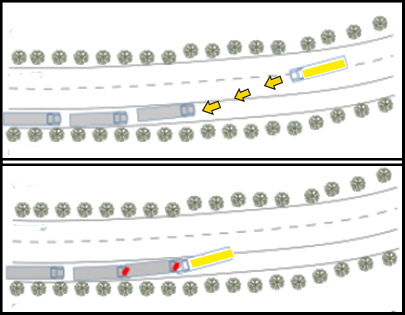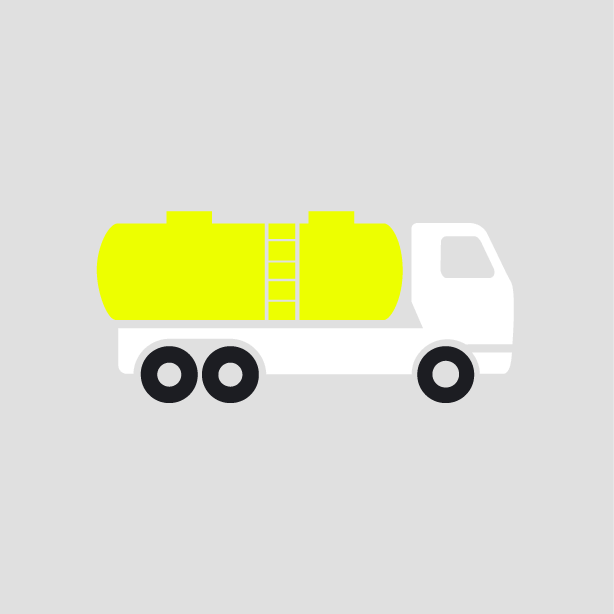-
What happened?
While travelling just under the speed limit, a driver lost control of a fuel truck due to extreme coughing after choking on a drink.
It collided head-on with a second truck parked next to the road, which was pushed into a third truck. An airbag deployed and possibly saved the driver’s life.
A fuel chamber was punctured, releasing 12,000 litres (2600 gallons) of diesel onto the road and into the drains. The truck was damaged beyond repair.
The driver suffered from shock but no physical injury. The second driver was hospitalised with a dislocated shoulder. The third driver suffered scratches to the face.
The fire service was alerted by a driver of a private vehicle.
The incident was reported to the haulier via media reports, and not by the driver or the police or any automated emergency notification system in the vehicle.

-
Why did it happen?
The truck company did not have a policy on eating/drinking while driving.
The autonomous emergency braking (AEB) system was turned on, but did not stop the truck as designed, and the driver pressed the accelerator by mistake in an attempt to brake.
The trailer was forced into the cab, which punctured the fuel chamber, because the saddle plate with fifth-wheel coupling and kingpin unexpectedly broke off when the cab came to a sudden stop.
The coupling was designed to provide towing stability but had potential limitations during head-on collisions that were not fully understood.
The emergency response plan did not include the driver being unable to notify the haulier, and the police not using the numbers displayed on the truck.

-
What did they learn?
Ensure there is effective training covering the risks of eating and drinking while driving, such as choking and losing consciousness.
Ensure understanding of the limitations of automated driver assistance systems like autonomous emergency braking AEB.
Review airbag installations in trucks.
Explore potential limitations of trailer-cab coupling designs during head-on collisions.
Review options for automatic emergency alarms whenever an HGV is involved in an accident.
Ensure rest periods are not being taken during loading or unloading, so that rest breaks are used for recovery including eating and drinking.

-
Ask yourself or your crew
What is our policy on eating and drinking while driving?
What does our rest break practice in context of driving time and other work activities look like?
How well do we and our drivers understand our vehicle protective systems, such as automatic braking, air bags, lane keeping systems etc.?
What would happen to our trailer-cab couplings in a collision?
How effective is our emergency response plan for vehicle-related incidents?
What can we do to eliminate or reduce the risk of collisions?

Add to homescreen
Content name
Select existing category:
Content name
New collection
Edit collection
What happened?
While travelling just under the speed limit, a driver lost control of a fuel truck due to extreme coughing after choking on a drink.
It collided head-on with a second truck parked next to the road, which was pushed into a third truck. An airbag deployed and possibly saved the driver’s life.
A fuel chamber was punctured, releasing 12,000 litres (2600 gallons) of diesel onto the road and into the drains. The truck was damaged beyond repair.
The driver suffered from shock but no physical injury. The second driver was hospitalised with a dislocated shoulder. The third driver suffered scratches to the face.
The fire service was alerted by a driver of a private vehicle.
The incident was reported to the haulier via media reports, and not by the driver or the police or any automated emergency notification system in the vehicle.

Why did it happen?
The truck company did not have a policy on eating/drinking while driving.
The autonomous emergency braking (AEB) system was turned on, but did not stop the truck as designed, and the driver pressed the accelerator by mistake in an attempt to brake.
The trailer was forced into the cab, which punctured the fuel chamber, because the saddle plate with fifth-wheel coupling and kingpin unexpectedly broke off when the cab came to a sudden stop.
The coupling was designed to provide towing stability but had potential limitations during head-on collisions that were not fully understood.
The emergency response plan did not include the driver being unable to notify the haulier, and the police not using the numbers displayed on the truck.
What did they learn?
Ensure there is effective training covering the risks of eating and drinking while driving, such as choking and losing consciousness.
Ensure understanding of the limitations of automated driver assistance systems like autonomous emergency braking AEB.
Review airbag installations in trucks.
Explore potential limitations of trailer-cab coupling designs during head-on collisions.
Review options for automatic emergency alarms whenever an HGV is involved in an accident.
Ensure rest periods are not being taken during loading or unloading, so that rest breaks are used for recovery including eating and drinking.
Ask yourself or your crew
What is our policy on eating and drinking while driving?
What does our rest break practice in context of driving time and other work activities look like?
How well do we and our drivers understand our vehicle protective systems, such as automatic braking, air bags, lane keeping systems etc.?
What would happen to our trailer-cab couplings in a collision?
How effective is our emergency response plan for vehicle-related incidents?
What can we do to eliminate or reduce the risk of collisions?
A truck collided head-on after the driver choke on his drink and became unconscious. The truck damage was beyond repair. 12,000 litres (2600 gallons) of diesel were released onto the road and into the drains.












